Toward Greener Supply Chains by Decarbonizing City Logistics: A Systematic Literature Review and Research Pathways
Abstract
:1. Introduction
2. Research Background and Motivation
2.1. Research Background
2.2. Research Motivation
3. Method
4. Bibliometric Analysis and Discussion
4.1. Publication Years
4.2. Publication by Journals
4.3. Publication by Country
4.4. Keyword Analysis
5. A Recap of Proposed DCL Solutions and QBL Aspects in the Extant Literature
| Paper | QBL Aspects 1 | Analytical Aspects 2 | Proposition | ||||||
|---|---|---|---|---|---|---|---|---|---|
| EC | EN | SO | CU | CT | EM | TR | SI | ||
| Ahani et al. (2023) [52] | ✔ | ✔ | ✔ | Optimal type and number of vehicles: freight transport | |||||
| Akbar et al. (2024) [62] | ✔ | ✔ | ✔ | Crowdshipping for inter-urban freight transport | |||||
| Akkad & Bányai (2020) [53] | ✔ | ✔ | ✔ | ✔ | Optimization of freight distribution with EVs | ||||
| Aloui et al. (2021) [63] | ✔ | ✔ | ✔ | ✔ | ✔ | Inventory, location, and routing optimization | |||
| Anderluh et al. (2021) [43] | ✔ | ✔ | ✔ | ✔ | ✔ | Route optimization (2E-VRP) in grey zone deliveries | |||
| Arnold et al. (2018) [64] | ✔ | ✔ | ✔ | Cargo bikes for freight delivery | |||||
| Azad et al. (2023) [58] | ✔ | ✔ | E-trikes for delivery | ||||||
| Bi et al. (2020) [65] | ✔ | ✔ | ✔ | ✔ | Optimal location for crowdsourcing stations | ||||
| Büttgen et al. (2021) [66] | ✔ | ✔ | ✔ | ✔ | Optimal route and location with e-vans/cargo bikes | ||||
| Ceccato & Gastaldi (2023) [67] | ✔ | ✔ | ✔ | Cargo bikes for home deliveries | |||||
| Chen et al. (2018) [68] | ✔ | ✔ | ✔ | ✔ | ✔ | Underground freight transport system | |||
| Chen et al. (2023) [42] | ✔ | ✔ | ✔ | Optimal cold chain distribution with EVs | |||||
| Dupas et al. (2020) [54] | ✔ | ✔ | ✔ | ✔ | Optimization of freight transport flow | ||||
| Dupas et al. (2023) [69] | ✔ | ✔ | ✔ | ✔ | Optimal location selection for urban consolidation centers | ||||
| Enthoven et al. (2020) [46] | ✔ | ✔ | ✔ | Bikes and parcel lockers: optimal delivery (VRP) | |||||
| Fan (2023) [70] | ✔ | ✔ | ✔ | ✔ | Route optimization for EVs | ||||
| Fan (2024) [47] | ✔ | ✔ | ✔ | Route optimization for EVs | |||||
| Fan et al. (2023) [48] | ✔ | ✔ | ✔ | Route optimization: multi-compartment vehicles | |||||
| Fontaine et al. (2023) [71] | ✔ | ✔ | ✔ | City freighters for two-echelon freight delivery | |||||
| Fraselle et al. (2021) [12] | ✔ | ✔ | ✔ | ✔ | E.V.s and cargo bikes for freight delivery | ||||
| Gatta et al. (2018) [72] | ✔ | ✔ | ✔ | Crowdshipping using the mass transit network | |||||
| Gatta et al. (2019) [60] | ✔ | ✔ | Crowdsourced delivery | ||||||
| Giordano et al. (2018) [56] | ✔ | ✔ | ✔ | EVs for freight transport | |||||
| Gruzauskas et al. (2023) [73] | ✔ | ✔ | Information sharing impact on food delivery | ||||||
| Guo et al. (2019) [74] | ✔ | ✔ | ✔ | Crowdsourced delivery for last-mile logistics | |||||
| Guo et al. (2022) [7] | ✔ | ✔ | ✔ | ✔ | Urban logistics enterprise | ||||
| Hassouna (2022) [75] | ✔ | ✔ | EVs for freight transport | ||||||
| Islam et al. (2021) [9] | ✔ | ✔ | ✔ | Hydrogen vehicles/route optimization | |||||
| Jaegler et al. (2024) [59] | ✔ | ✔ | ✔ | Optimization with inland waterway and EVs | |||||
| Jiao et al. (2023) [10] | ✔ | ✔ | ✔ | Location selection for urban logistics centers | |||||
| Jones et al. (2020) [57] | ✔ | ✔ | Hydrogen vehicles for freight transport | ||||||
| Kłodawski et al. (2024) [76] | ✔ | ✔ | ✔ | Intermodal terminals for reduced energy use | |||||
| Kwasiborska et al. (2023) [77] | ✔ | ✔ | ✔ | Delivery: e-scooters and unmanned aerial vehicles | |||||
| Labarthe et al. (2024) [78] | ✔ | ✔ | ✔ | ✔ | Joint use of transport modes for freight and passengers | ||||
| Lee et al. (2020) [49] | ✔ | ✔ | ✔ | ✔ | Route optimization with mixed fleet | ||||
| Leyerer et al. (2020) [79] | ✔ | ✔ | ✔ | ✔ | Optimal locations for refrigerated grocery lockers | ||||
| Li et al. (2021) [41] | ✔ | ✔ | ✔ | ✔ | ✔ | Logistics infrastructure investment options | |||
| Liu et al. (2021) [80] | ✔ | ✔ | ✔ | ✔ | E-grocery delivery: optimal locations and routes | ||||
| Ma et al. (2024) [81] | ✔ | ✔ | ✔ | EVs: route optimization | |||||
| Märzinger et al. (2021) [82] | ✔ | ✔ | EVs and charging stations | ||||||
| Moll et al. (2020) [83] | ✔ | ✔ | ✔ | Electric trucks for freight delivery | |||||
| Nocera & Cavallaro (2017) [84] | ✔ | ✔ | Urban distribution center GHGs assessment | ||||||
| Olapiriyakul & Nguyen (2019) [55] | ✔ | ✔ | ✔ | ✔ | ✔ | Warehouse location selection and material flow | |||
| Peng et al. (2024) [85] | ✔ | ✔ | ✔ | EVs for dispatching in freight transport | |||||
| Peppel & Spinler (2022) [86] | ✔ | ✔ | ✔ | ✔ | Optimal parcel locker location | ||||
| Perera et al. (2020) [87] | ✔ | ✔ | ✔ | ✔ | ✔ | ✔ | Link toll (A new toll-charging scheme) | ||
| Pietrzak et al. (2021) [88] | ✔ | ✔ | ✔ | Rail transport for urban freight delivery | |||||
| Pilati et al. (2020) [89] | ✔ | ✔ | EVs for parcel delivery | ||||||
| Pourmohammad-Zia & van Koningsveld (2024) [39] | ✔ | ✔ | ✔ | Waterway based distribution/EVs in last-mile delivery | |||||
| Ramirez-Villamil et al. (2022) [90] | ✔ | ✔ | ✔ | Route optimization (2E-VRP): stochastic travel times | |||||
| Ramírez-Villamil et al. (2023) [91] | ✔ | ✔ | ✔ | ✔ | Route optimization for parcel delivery | ||||
| Resat (2020) [92] | ✔ | ✔ | ✔ | ✔ | ✔ | Optimal cargo distribution using drones | |||
| Saeedi et al. (2018) [93] | ✔ | ✔ | ✔ | ✔ | ✔ | Location selection for urban distribution centers | |||
| Sayarshad et al. (2021) [44] | ✔ | ✔ | ✔ | ✔ | ✔ | Optimal routing and scheduling: EVs | |||
| Simoni et al. (2020) [94] | ✔ | ✔ | Crowdsourced delivery | ||||||
| Teimoury & Rashid (2024) [95] | ✔ | ✔ | ✔ | ✔ | ✔ | ✔ | ✔ | Optimal freight transport using drones and trucks | |
| Vajihi, M & Ricci (2021) [96] | ✔ | ✔ | ✔ | Urban rail system for freight distribution | |||||
| Villa & Monzón (2021) [61] | ✔ | ✔ | ✔ | Metro based delivery system with parcel lockers | |||||
| Voegl et al. (2019) [97] | ✔ | Developed unloading infrastructure to reduce GHGs | |||||||
| Wang et al. (2023) [98] | ✔ | ✔ | ✔ | ✔ | ✔ | ✔ | Location selection for urban logistics centers | ||
| Wehbi et al. (2022) [45] | ✔ | ✔ | ✔ | Optimal routes: on-foot porter for last-mile delivery | |||||
| Wei et al. (2020) [51] | ✔ | ✔ | ✔ | ✔ | Underground logistics network optimization | ||||
| Wong et al. (2020) [50] | ✔ | ✔ | ✔ | ✔ | Route optimization | ||||
| Zhang & Cheah (2024) [99] | ✔ | ✔ | ✔ | Crowdshipping for freight delivery | |||||
6. Evolution of DCL Research and Concluding Remarks
Author Contributions
Funding
Data Availability Statement
Conflicts of Interest
References
- IPCC. CC Widespread, Rapid, and Intensifying. 2021. Available online: https://www.ipcc.ch/2021/08/09/ar6-wg1-20210809-pr/ (accessed on 14 September 2023).
- Yun, N.Y.; Ülkü, M.A. Sustainable supply chain risk management in a climate-changed world: Review of extant literature, trend analysis, and guiding framework for future research. Sustainability 2023, 15, 13199. [Google Scholar] [CrossRef]
- United Nations. What Is Climate Change? 2020. Available online: https://www.un.org/en/climatechange/what-is-climate-change (accessed on 20 May 2023).
- NOAA. Climate Change Impacts. 2021. Available online: https://www.noaa.gov/education/resource-collections/climate/climate-change-impacts (accessed on 5 June 2023).
- Koç, Ç.; Bektaş, T.; Jabali, O.; Laporte, G. The fleet size and mix pollution-routing problem. Transp. Res. Part B Methodol. 2014, 70, 239–254. [Google Scholar] [CrossRef]
- Wang, A.; Lyu, Q. Research progress and prospect of tourism carbon emissions and its uncertainty analysis under the goal of low-carbon scenic spots. Proc. Bus. Econ. Stud. 2023, 6, 25–32. [Google Scholar] [CrossRef]
- Guo, J.; Zhao, Q.; Xi, M. Sustainable urban logistics distribution network planning with carbon tax. Sustainability 2022, 14, 13184. [Google Scholar] [CrossRef]
- Bruglieri, M.; Mancini, S.; Pezzella, F.; Pisacane, O. A path-based solution approach for the green vehicle routing problem. Comput. Oper. Res. 2019, 103, 109–122. [Google Scholar] [CrossRef]
- Islam, M.A.; Gajpal, Y.; ElMekkawy, T.Y. Mixed fleet based green clustered logistics problem under carbon emission cap. Sustain. Cities Soc. 2021, 72, 103074. [Google Scholar] [CrossRef]
- Jiao, H.; Yang, F.; Xu, S.; Huang, S. Using large-scale truck trajectory data to explore the location of sustainable urban logistics centres—The case of Wuhan. ISPRS Int. J. Geo-Inf. 2023, 12, 88. [Google Scholar] [CrossRef]
- Mansouri, B.; Sahu, S.; Ülkü, M.A. Toward greening city logistics: A systematic review on corporate governance and social responsibility in managing urban distribution centres. Logistics 2023, 7, 19. [Google Scholar] [CrossRef]
- Fraselle, J.; Limbourg, S.L.; Vidal, L. Cost and environmental impacts of a mixed fleet of vehicles. Sustainability 2021, 13, 9413. [Google Scholar] [CrossRef]
- Habib, M.A. Transit systems and the quality of life. In Encyclopedia of Quality of Life and Well-Being Research; Maggino, F., Ed.; Springer: Cham, Switzerland, 2024; pp. 7291–7293. [Google Scholar] [CrossRef]
- Kaufman, F.D.; Ülkü, M.A. An interdisciplinary inquiry into sustainable supply chain management. In Handbook of Research on Supply Chain Management for Sustainable Development; I.G.I. Global: Hershey, PA, USA, 2018; pp. 1–17. [Google Scholar]
- Li, J.; Dang, S.; Wen, M.; Li, Q.; Chen, Y.; Huang, Y.; Shang, W. Index modulation multiple access for 6G communications: Principles, applications, and challenges. IEEE Netw. 2023, 37, 52–60. [Google Scholar] [CrossRef]
- Wen, M.; Zheng, B.; Kim, K.J.; Di Renzo, M.; Tsiftsis, T.A.; Chen, K.C.; Al-Dhahir, N. A survey on spatial modulation in emerging wireless systems: Research progresses and applications. IEEE J. Sel. Areas Commun. 2019, 37, 1949–1972. [Google Scholar] [CrossRef]
- Pacura, W.; Szramowiat-Sala, K.; Gołaś, J. Emissions from light-duty vehicles—From statistics to emission regulations and vehicle testing in the European Union. Energies 2023, 17, 209. [Google Scholar] [CrossRef]
- CARB. Zero-Emission Vehicles and the Advanced Clean Cars Regulations. 2024. Available online: https://ww2.arb.ca.gov/resources/documents/cars-and-light-trucks-are-going-zero-frequently-asked-questions#:~:text=As%20part%20of%20the%20Advanced,zero%2Demission%20vehicles%20by%202035 (accessed on 6 August 2023).
- Cain, M.; Jenkins, S.; Allen, M.R.; Lynch, J.; Frame, D.J.; Macey, A.H.; Peters, G.P. Methane and the Paris Agreement temperature goals. Philos. Trans. R. Soc. A 2022, 380, 20200456. [Google Scholar] [CrossRef] [PubMed]
- Ülkü, M.A.; Engau, A. Sustainable supply chain analytics. In Industry, Innovation and Infrastructure; Leal Filho, W., Azul, A.M., Brandli, L., Lange Salvia, A., Wall, T., Eds.; Encyclopedia of the U.N. Sustainable Development Goals; Springer: Cham, Switzerland, 2021; pp. 1123–1134. [Google Scholar]
- Viu-Roig, M.; Alvarez-Palau, E.J. The impact of E-Commerce-related last-mile logistics on cities: A systematic literature review. Sustainability 2020, 12, 6492. [Google Scholar] [CrossRef]
- Lauenstein, S.; Schank, C. Design of a sustainable last mile in urban logistics—A systematic literature review. Sustainability 2022, 14, 5501. [Google Scholar] [CrossRef]
- World Bank. Urban Development. 2023. Available online: https://www.worldbank.org/en/topic/urbandevelopment/overview (accessed on 20 April 2024).
- Hussain, M.; Imitiyaz, I. Urbanization concepts, dimensions and factors. Int. J. Recent Sci. Res. 2018, 9, 23513–23523. [Google Scholar]
- Statista. Percentage of Population Living in Urban Areas Worldwide from 1950 to 2050, by Regional Development. 2018. Available online: https://www.statista.com/statistics/671366/change-in-urbanization-of-countries-worldwide-by-regional-development/ (accessed on 20 April 2024).
- Savelsbergh, M.; Van Woensel, T. City logistics: Challenges and opportunities: 50th anniversary invited article. Transp. Sci. 2016, 50, 579–590. [Google Scholar] [CrossRef]
- Calisto Friant, M.; Reid, K.; Boesler, P.; Vermeulen, W.J.; Salomone, R. Sustainable circular cities? Analysing urban circular economy policies in Amsterdam, Glasgow, and Copenhagen. Local Environ. 2023, 28, 1331–1369. [Google Scholar]
- Swamy, S.; Baindur, D. Managing urban logistics in an expanding city—Case study of Ahmedabad. World Conf. Transp. Res. 2013, 380009, 1–21. [Google Scholar]
- Statista. Retail E-Commerce Sales Worldwide from 2014 to 2027. 2023. Available online: https://www.statista.com/statistics/379046/worldwide-retail-e-commerce-sales/#statisticContainer (accessed on 21 April 2024).
- Statista. Revenue of the Online Food Delivery Market Worldwide from 2017 to 2028, by Segment. 2024. Available online: https://www.statista.com/statistics/1170631/online-food-delivery-market-size-worldwide/ (accessed on 21 April 2024).
- Statista. Market Share of Leading Retail E-Commerce Companies in the United States in 2023. 2023. Available online: https://www.statista.com/statistics/274255/market-share-of-the-leading-retailers-in-us-e-commerce/ (accessed on 7 August 2024).
- Statista. Annual Net Sales Revenue of Amazon from 2004 to 2023. 2024. Available online: https://www.statista.com/statistics/266282/annual-net-revenue-of-amazoncom/ (accessed on 20 April 2024).
- Rodrigue, J.P. The distribution network of Amazon and the footprint of freight digitalization. J. Transp. Geogr. 2020, 88, 102825. [Google Scholar] [CrossRef]
- Statista. Market Share of Leading Online Meal Delivery Companies in the United States as of March 2024. 2024. Available online: https://www.statista.com/statistics/1235724/market-share-us-food-delivery-companies/ (accessed on 7 August 2024).
- Poon, W.C.; Tung, S.E.H. The rise of online food delivery culture during the COVID-19 pandemic: An analysis of intention and its associated risk. Eur. J. Manag. Bus. Econ. 2024, 33, 54–73. [Google Scholar] [CrossRef]
- Alnaggar, A.; Gzara, F.; Bookbinder, J.H. Crowdsourced delivery: A review of platforms and academic literature. Omega 2021, 98, 102139. [Google Scholar] [CrossRef]
- Ülkü, M.A.; Bookbinder, J.H.; Yun, N.Y. Leveraging industry 4.0 technologies for sustainable humanitarian supply chains: Evidence from the extant literature. Sustainability 2024, 16, 1321. [Google Scholar] [CrossRef]
- Statista. Total Population of China from 1980 to 2023 with Forecasts Until 2029. 2024. Available online: https://www.statista.com/statistics/263765/total-population-of-china/ (accessed on 16 April 2024).
- Pourmohammad-Zia, N.; van Koningsveld, M. Sustainable urban logistics: A case study of waterway integration in Amsterdam. Sustain. Cities Soc. 2024, 105, 105334. [Google Scholar] [CrossRef]
- Ülkü, M.A. Dare to care: Shipment consolidation reduces not only costs, but also environmental damage. Int. J. Prod. Econ. 2012, 139, 438–446. [Google Scholar] [CrossRef]
- Li, S.; Liang, Y.; Wang, Z.; Zhang, D. An optimization model of a sustainable city logistics network design based on goal programming. Sustainability 2021, 13, 7418. [Google Scholar] [CrossRef]
- Chen, W.; Zhang, D.; Van Woensel, T.; Xu, G.; Guo, J. Green vehicle routing using mixed fleets for cold chain distribution. Expert Syst. Appl. 2023, 233, 120979. [Google Scholar] [CrossRef]
- Anderluh, A.; Nolz, P.C.; Hemmelmayr, V.C.; Crainic, T.G. Multi-objective optimization of a two-echelon vehicle routing problem with vehicle synchronization and ‘grey zone’ customers arising in urban logistics. Eur. J. Oper. Res. 2021, 289, 940–958. [Google Scholar] [CrossRef]
- Sayarshad, H.R.; Mahmoodian, V.; Bojović, N. Dynamic inventory routing and pricing problem with a mixed fleet of electric and conventional urban freight vehicles. Sustainability 2021, 13, 6703. [Google Scholar] [CrossRef]
- Wehbi, L.; Bektaş, T.; Iris, Ç. Optimising vehicle and on-foot porter routing in urban logistics. Transp. Res. Part D Transp. Environ. 2022, 109, 103371. [Google Scholar] [CrossRef]
- Enthoven, D.L.; Jargalsaikhan, B.; Roodbergen, K.J.; Uit het Broek, M.A.; Schrotenboer, A.H. The two-echelon vehicle routing problem with covering options: City logistics with cargo bikes and parcel lockers. Comput. Oper. Res. 2020, 118, 104919. [Google Scholar] [CrossRef]
- Fan, L. A two-stage hybrid ant colony algorithm for multi-depot half-open time-dependent electric vehicle routing problem. Complex Intell. Syst. 2024, 10, 2107–2128. [Google Scholar] [CrossRef]
- Fan, X.; Yao, G.; Yang, Y. Multi-compartment vehicle routing problem considering traffic congestion under the mixed carbon policy. Appl. Sci. 2023, 13, 10304. [Google Scholar] [CrossRef]
- Lee, K.; Chae, J.; Song, B.; Choi, D. A model for sustainable courier services: Vehicle routing with exclusive lanes. Sustainability 2020, 12, 1077. [Google Scholar] [CrossRef]
- Wong, E.Y.C.; Tai, A.H.; So, S. Container drayage modelling with graph theory-based road connectivity assessment for sustainable freight transportation in new development area. Comput. Ind. Eng. 2020, 149, 106810. [Google Scholar] [CrossRef]
- Wei, H.; Li, A.; Jia, N. Research on optimization and design of sustainable urban underground logistics network framework. Sustainability 2020, 12, 9147. [Google Scholar] [CrossRef]
- Ahani, P.; Arantes, A.; Garmanjani, R.; Melo, S. Optimizing vehicle replacement in sustainable urban freight transportation subject to presence of regulatory measures. Sustainability 2023, 15, 12266. [Google Scholar] [CrossRef]
- Akkad, M.Z.; Bányai, T. Multi-objective approach for optimization of city logistics considering energy efficiency. Sustainability 2020, 12, 7366. [Google Scholar] [CrossRef]
- Dupas, R.; Taniguchi, E.; Deschamps, J.C.; Qureshi, A.G. A multi-commodity network flow model for sustainable performance evaluation in city logistics: Application to the distribution of multi-tenant buildings in Tokyo. Sustainability 2020, 12, 2180. [Google Scholar] [CrossRef]
- Olapiriyakul, S.; Nguyen, T.T. Land use and public health impact assessment in a supply chain network design problem: A case study. J. Transp. Geogr. 2019, 75, 70–81. [Google Scholar] [CrossRef]
- Giordano, A.; Fischbeck, P.; Matthews, H.S. Environmental and economic comparison of diesel and battery electric delivery vans to inform city logistics fleet replacement strategies. Transp. Res. Part D Transp. Environ. 2018, 64, 216–229. [Google Scholar] [CrossRef]
- Jones, J.; Genovese, A.; Tob-Ogu, A. Hydrogen vehicles in urban logistics: A total cost of ownership analysis and some policy implications. Renew. Sustain. Energy Rev. 2020, 119, 109595. [Google Scholar] [CrossRef]
- Azad, M.; Rose, W.J.; MacArthur, J.H.; Cherry, C.R. E-trikes for urban delivery: An empirical mixed-fleet simulation approach to assess city logistics sustainability. Sustain. Cities Soc. 2023, 96, 104641. [Google Scholar] [CrossRef]
- Jaegler, A.; Randrianarisoa, L.M.; Yahyaoui, H. Policy decision-support for inland waterway transport in sustainable urban areas: An analysis of economic viability. Ann. Oper. Res. 2024, 1–19. [Google Scholar] [CrossRef]
- Gatta, V.; Marcucci, E.; Nigro, M.; Serafini, S. Sustainable urban freight transport adopting public transport-based crowdshipping for B2C deliveries. Eur. Transp. Res. Rev. 2019, 11, 1–14. [Google Scholar] [CrossRef]
- Villa, R.; Monzón, A. A metro-based system as sustainable alternative for urban logistics in the era of e-commerce. Sustainability 2021, 13, 4479. [Google Scholar] [CrossRef]
- Akbar, U.; Jain, A.A.; Bråthen, S. Sustainability assessment of inter-urban crowdshipping-A case study approach. Res. Transp. Econ. 2024, 103, 101409. [Google Scholar] [CrossRef]
- Aloui, A.; Hamani, N.; Delahoche, L. An integrated optimization approach using a collaborative strategy for sustainable cities freight transportation: A Case study. Sustain. Cities Soc. 2021, 75, 103331. [Google Scholar] [CrossRef]
- Arnold, F.; Cardenas, I.; Sörensen, K.; Dewulf, W. Simulation of B2C e-commerce distribution in Antwerp using cargo bikes and delivery points. Eur. Transp. Res. Rev. 2018, 10, 2. [Google Scholar] [CrossRef]
- Bi, K.; Yang, M.; Zahid, L.; Zhou, X. A new solution for city distribution to achieve environmental benefits within the trend of green logistics: A case study in China. Sustainability 2020, 12, 8312. [Google Scholar] [CrossRef]
- Büttgen, A.; Turan, B.; Hemmelmayr, V. Evaluating distribution costs and co2-emissions of a two-stage distribution system with cargo bikes: A case study in the city of innsbruck. Sustainability 2021, 13, 13974. [Google Scholar] [CrossRef]
- Ceccato, R.; Gastaldi, M. Last mile distribution using cargo bikes: A simulation study in Padova. Eur. Transp./Trasp. Eur. 2023, 90, 1–11. [Google Scholar] [CrossRef]
- Chen, Y.; Guo, D.; Chen, Z.; Fan, Y.; Li, X. Using a multi-objective programming model to validate feasibility of an underground freight transportation system for the Yangshan port in Shanghai. Tunn. Undergr. Space Technol. 2018, 81, 463–471. [Google Scholar] [CrossRef]
- Dupas, R.; Deschamps, J.C.; Taniguchi, E.; Qureshi, A.G.; Hsu, T. Optimizing the location selection of urban consolidation centers with sustainability considerations in the city of Bordeaux. Res. Transp. Bus. Manag. 2023, 47, 100943. [Google Scholar] [CrossRef]
- Fan, L. A hybrid adaptive large neighborhood search for time-dependent open electric vehicle routing problem with hybrid energy replenishment strategies. PLoS ONE 2023, 18, e0291473. [Google Scholar] [CrossRef]
- Fontaine, P.; Minner, S.; Schiffer, M. Smart and sustainable city logistics: Design, consolidation, and regulation. Eur. J. Oper. Res. 2023, 307, 1071–1084. [Google Scholar] [CrossRef]
- Gatta, V.; Marcucci, E.; Nigro, M.; Patella, S.M.; Serafini, S. Public transport-based crowdshipping for sustainable city logistics: Assessing economic and environmental impacts. Sustainability 2018, 11, 145. [Google Scholar] [CrossRef]
- Gruzauskas, V.; Burinskiene, A.; Krisciunas, A. Application of information-sharing for resilient and sustainable food delivery in last-mile logistics. Mathematics 2023, 11, 303. [Google Scholar] [CrossRef]
- Guo, X.; Jaramillo, Y.J.L.; Bloemhof-Ruwaard, J.; Claassen, G.D.H. On integrating crowdsourced delivery in last-mile logistics: A simulation study to quantify its feasibility. J. Clean. Prod. 2019, 241, 118365. [Google Scholar] [CrossRef]
- Hassouna, F.M. Urban freight transport electrification in westbank, palestine: Environmental and economic benefits. Energies 2022, 15, 4058. [Google Scholar] [CrossRef]
- Kłodawski, M.; Jachimowski, R.; Chamier-Gliszczyński, N. Analysis of the overhead crane energy consumption using different container loading strategies in urban logistics hubs. Energies 2024, 17, 985. [Google Scholar] [CrossRef]
- Kwasiborska, A.; Stelmach, A.; Jabłońska, I. Quantitative and comparative analysis of energy consumption in urban logistics using unmanned aerial vehicles and selected means of transport. Energies 2023, 16, 6467. [Google Scholar] [CrossRef]
- Labarthe, O.; Ahmadi, G.; Klibi, W.; Deschamps, J.C.; Montreuil, B. A sustainable on-demand urban delivery service enabled by synchromodality and synergy in passenger and freight mobility. Transp. Res. Part C Emerg. Technol. 2024, 161, 104544. [Google Scholar] [CrossRef]
- Leyerer, M.; Sonneberg, M.O.; Heumann, M.; Breitner, M.H. Shortening the last mile in urban areas: Optimizing a smart logistics concept for e-grocery operations. Smart Cities 2020, 3, 585–603. [Google Scholar] [CrossRef]
- Liu, D.; Deng, Z.; Zhang, W.; Wang, Y.; Kaisar, E.I. Design of sustainable urban electronic grocery distribution network. Alex. Eng. J. 2021, 60, 145–157. [Google Scholar] [CrossRef]
- Ma, H.; Yang, R.; Li, X. Delivery routing for a mixed fleet of conventional and electric vehicles with road restrictions. Int. J. Prod. Res. 2024, 1–24. [Google Scholar] [CrossRef]
- Märzinger, T.; Wöss, D.; Steinmetz, P.; Müller, W.; Pröll, T. Novel modelling approach for the calculation of the loading performance of charging stations for e-trucks to represent fleet consumption. Energies 2021, 14, 3471. [Google Scholar] [CrossRef]
- Moll, C.; Plötz, P.; Hadwich, K.; Wietschel, M. Are battery-electric trucks for 24-hour delivery the future of city logistics?—A German case study. World Electr. Veh. J. 2020, 11, 16. [Google Scholar] [CrossRef]
- Nocera, S.; Cavallaro, F. A two-step method to evaluate the well-to-wheel carbon efficiency of urban consolidation centres. Res. Transp. Econ. 2017, 65, 44–55. [Google Scholar] [CrossRef]
- Peng, D.; Wu, G.; Boriboonsomsin, K. Bi-objective battery electric truck dispatching problem with backhauls and time windows. Transp. Res. Rec. 2024, 1–13. [Google Scholar] [CrossRef]
- Peppel, M.; Spinler, S. The impact of optimal parcel locker locations on costs and the environment. Int. J. Phys. Distrib. Logist. Manag. 2022, 52, 324–350. [Google Scholar] [CrossRef]
- Perera, L.; Thompson, R.G.; Wu, W. A multi-class toll-based approach to reduce total emissions on roads for sustainable urban transportation. Sustain. Cities Soc. 2020, 63, 102435. [Google Scholar] [CrossRef]
- Pietrzak, K.; Pietrzak, O.; Montwiłł, A. Effects of incorporating rail transport into a zero-emission urban deliveries system: Application of light freight railway (L.F.R.) electric trains. Energies 2021, 14, 6809. [Google Scholar] [CrossRef]
- Pilati, F.; Zennaro, I.; Battini, D.; Persona, A. The sustainable parcel delivery (S.P.D.) problem: Economic and environmental considerations for 3PLs. IEEE Access 2020, 8, 71880–71892. [Google Scholar] [CrossRef]
- Ramirez-Villamil, A.; Jaegler, A.; Montoya-Torres, J.R. Sustainable local pickup and delivery: The case of Paris. Res. Transp. Bus. Manag. 2022, 45, 100692. [Google Scholar] [CrossRef]
- Ramírez-Villamil, A.; Montoya-Torres, J.R.; Jaegler, A.; Cuevas-Torres, J.M. Reconfiguration of last-mile supply chain for parcel delivery using machine learning and routing optimization. Comput. Ind. Eng. 2023, 184, 109604. [Google Scholar] [CrossRef]
- Resat, H.G. Design and analysis of novel hybrid multi-objective optimization approach for data-driven sustainable delivery systems. IEEE Access 2020, 8, 90280–90293. [Google Scholar] [CrossRef]
- Saeedi, F.; Teimoury, E.; Makui, A. Designing sustainable city logistics distribution network using a probabilistic bi-objective mathematical model. Uncertain Supply Chain. Manag. 2018, 6, 357–374. [Google Scholar] [CrossRef]
- Simoni, M.D.; Marcucci, E.; Gatta, V.; Claudel, C.G. Potential last-mile impacts of crowdshipping services: A simulation-based evaluation. Transportation 2020, 47, 1933–1954. [Google Scholar] [CrossRef]
- Teimoury, E.; Rashid, R. A hybrid variable neighborhood search heuristic for the sustainable time-dependent truck-drone routing problem with rendezvous locations. J. Heuristics 2024, 30, 1–41. [Google Scholar] [CrossRef]
- Vajihi, M.; Ricci, S. Energy efficiency assessment of rail freight transport: Freight tram in Berlin. Energies 2021, 14, 3982. [Google Scholar] [CrossRef]
- Voegl, J.; Fikar, C.; Hirsch, P.; Gronalt, M. A simulation study to evaluate economic and environmental effects of different unloading infrastructure in an urban retail street. Comput. Ind. Eng. 2019, 137, 106032. [Google Scholar] [CrossRef]
- Wang, Y.; Li, Y.; Lu, C. Evaluating the effects of logistics center location: An analytical framework for sustainable urban logistics. Sustainability 2023, 15, 3091. [Google Scholar] [CrossRef]
- Zhang, M.; Cheah, L. Prioritizing outlier parcels for public transport-based crowdshipping in urban logistics. Transp. Res. Rec. 2024, 2678, 601–612. [Google Scholar] [CrossRef]
- Parmaksız, D.; Ülkü, M.A.; Weigand, H. Investigating rural logistics and transportation through the lens of quadruple bottom line sustainability. Logistics 2024, 8, 81. [Google Scholar] [CrossRef]
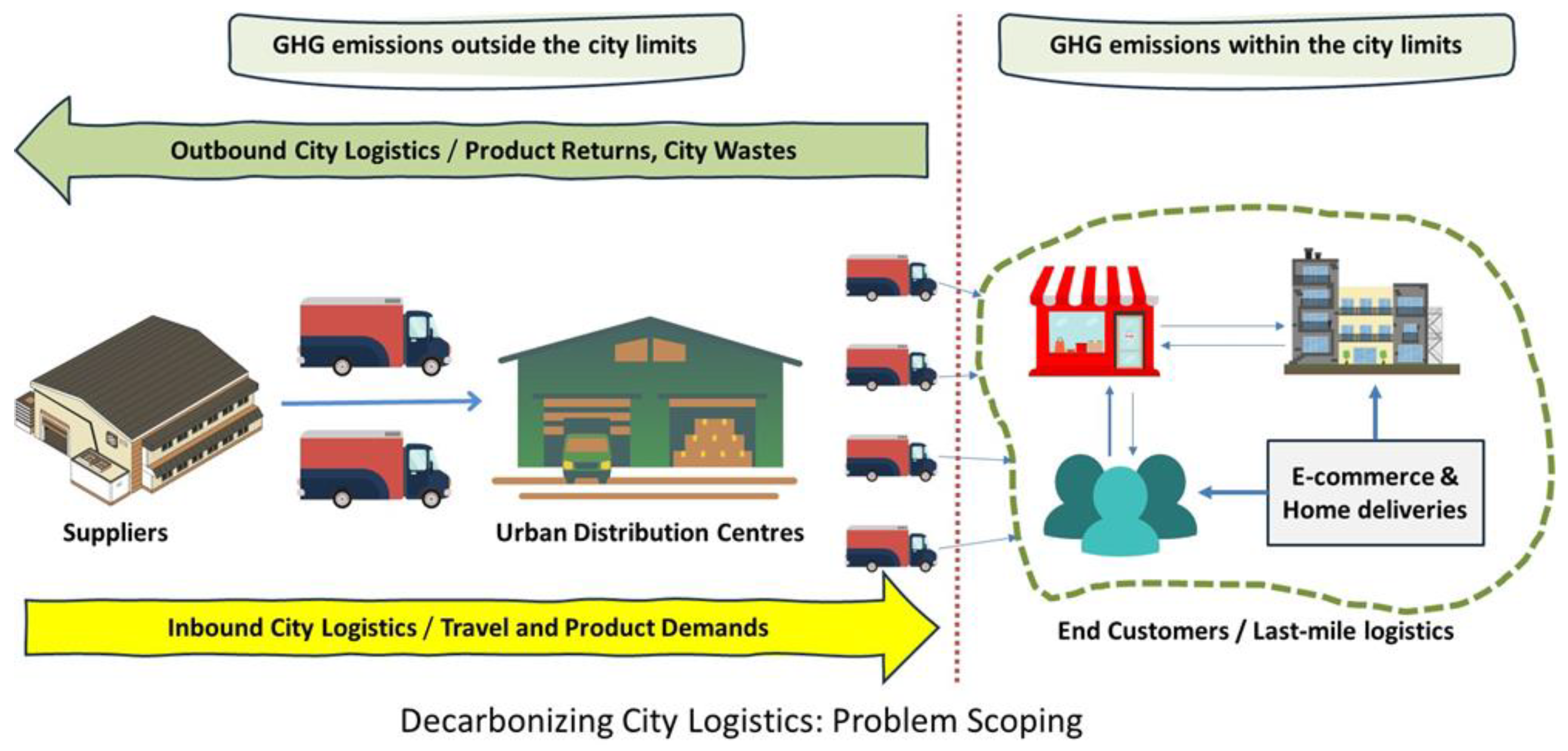
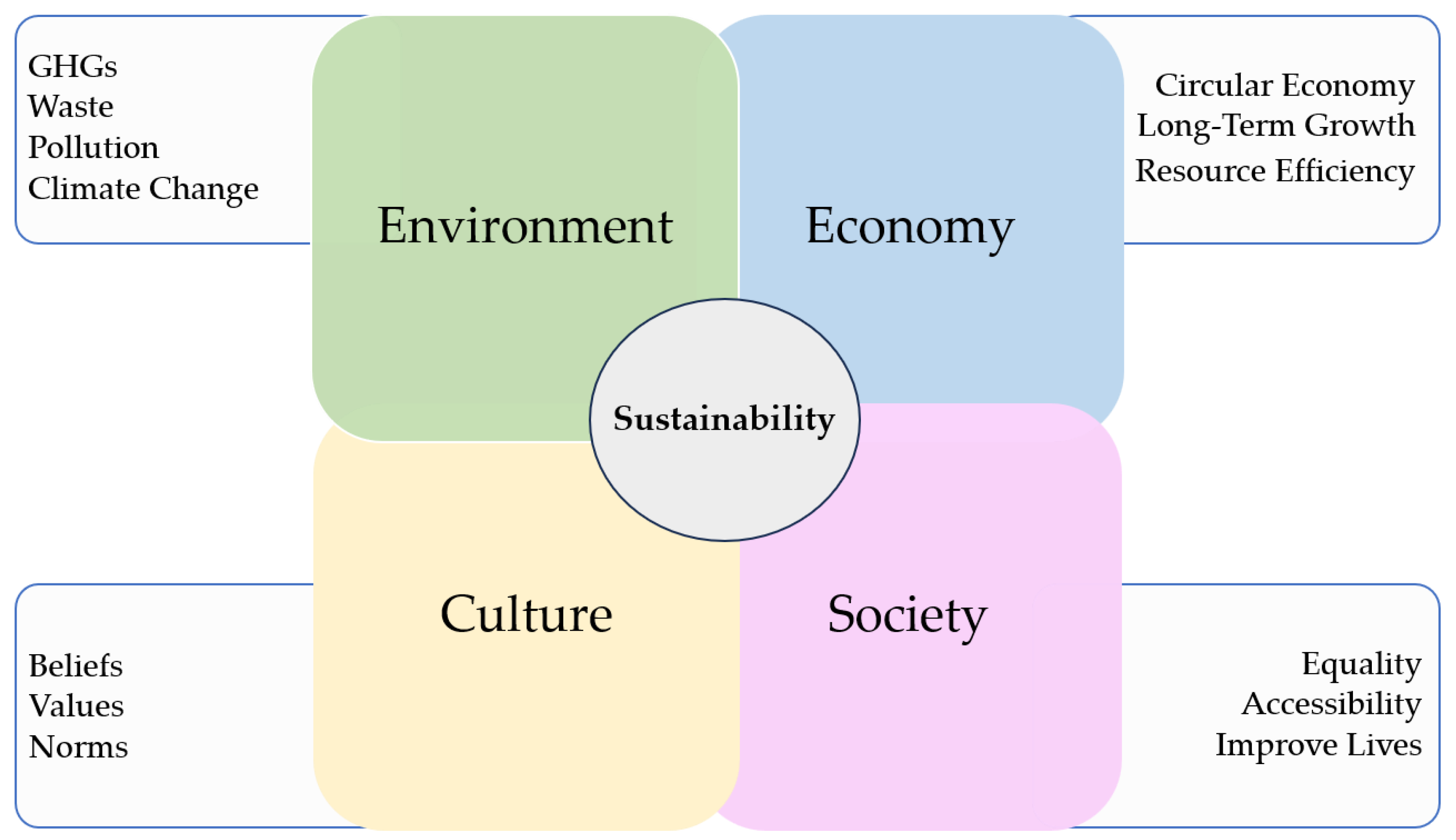
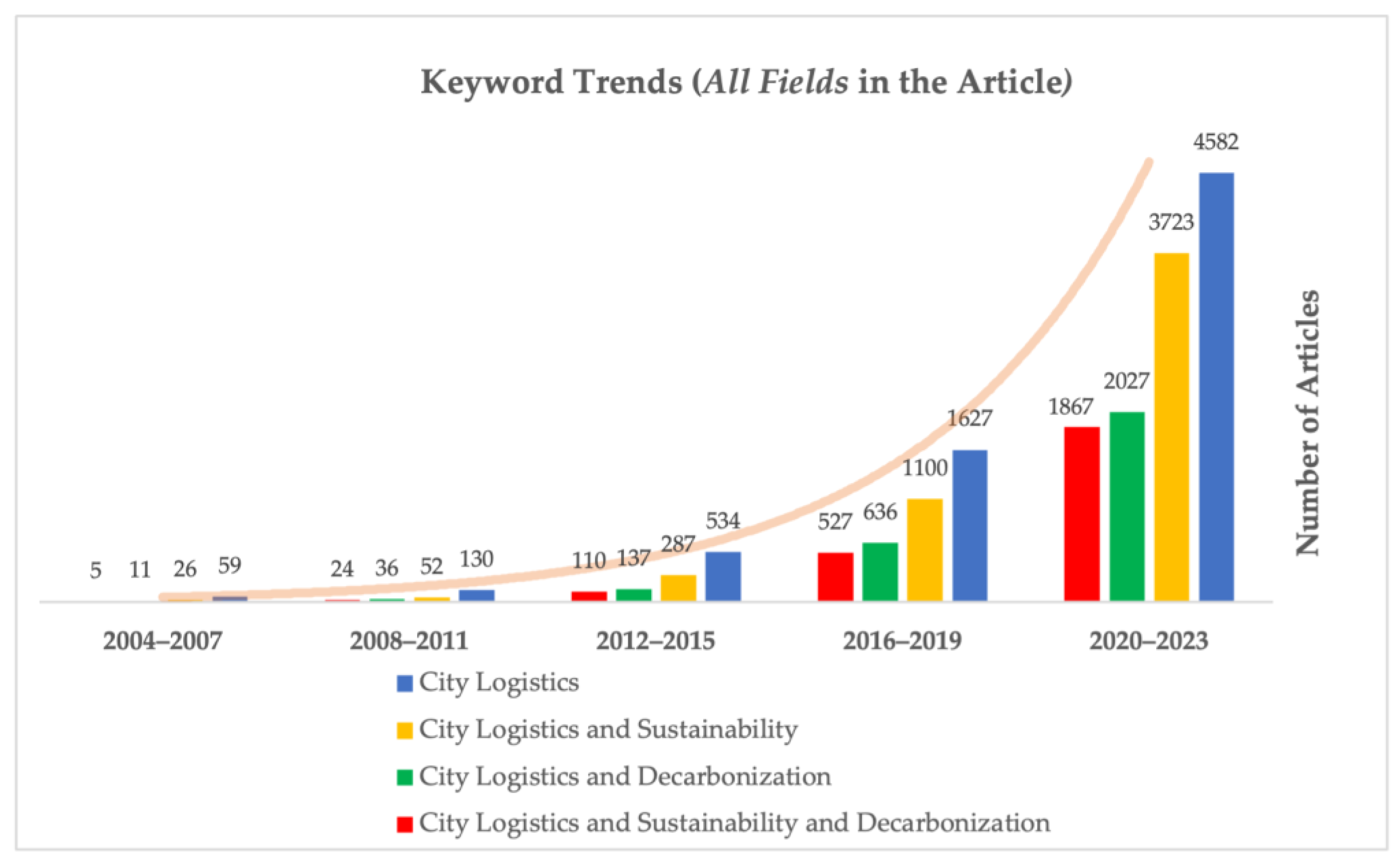
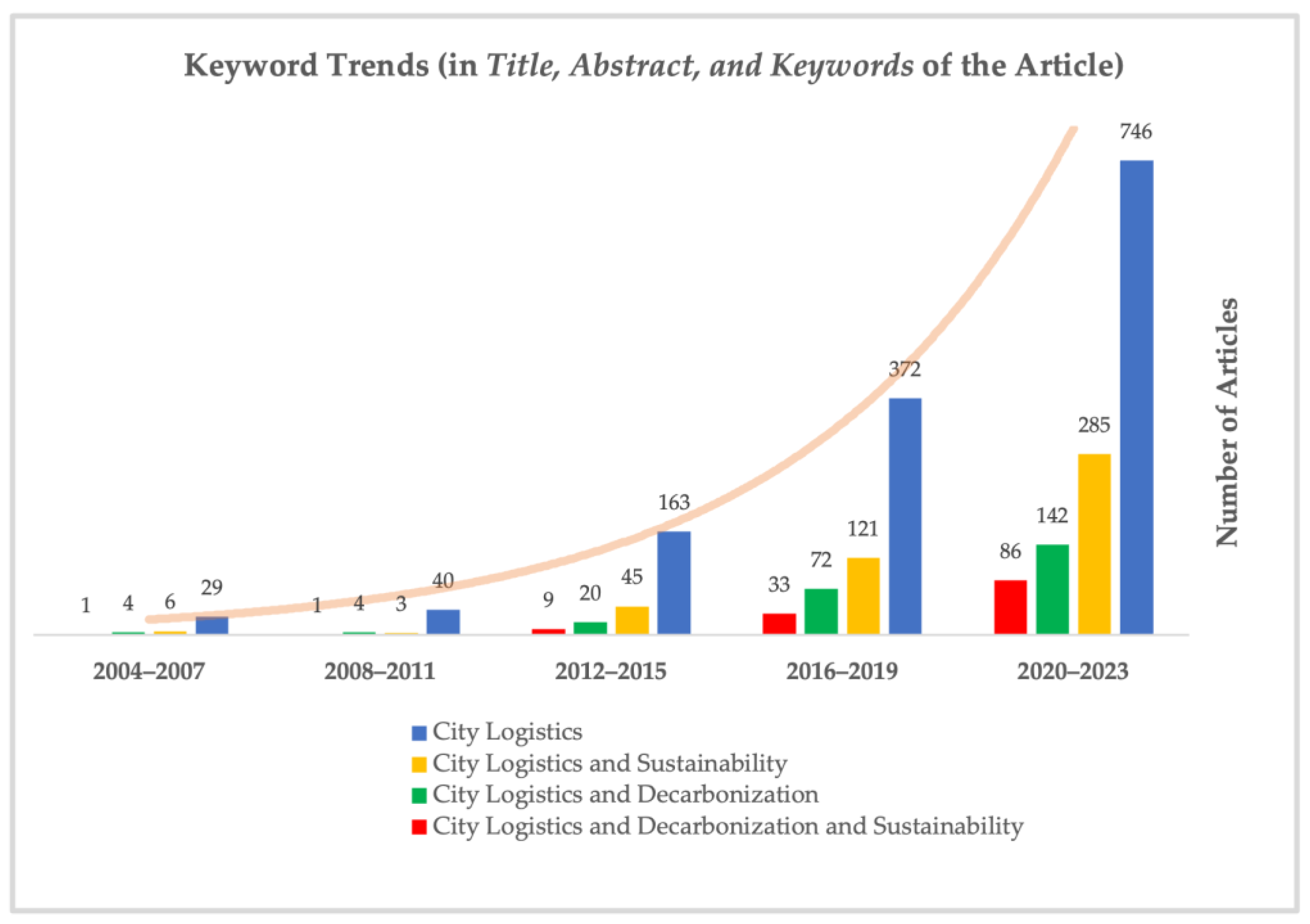
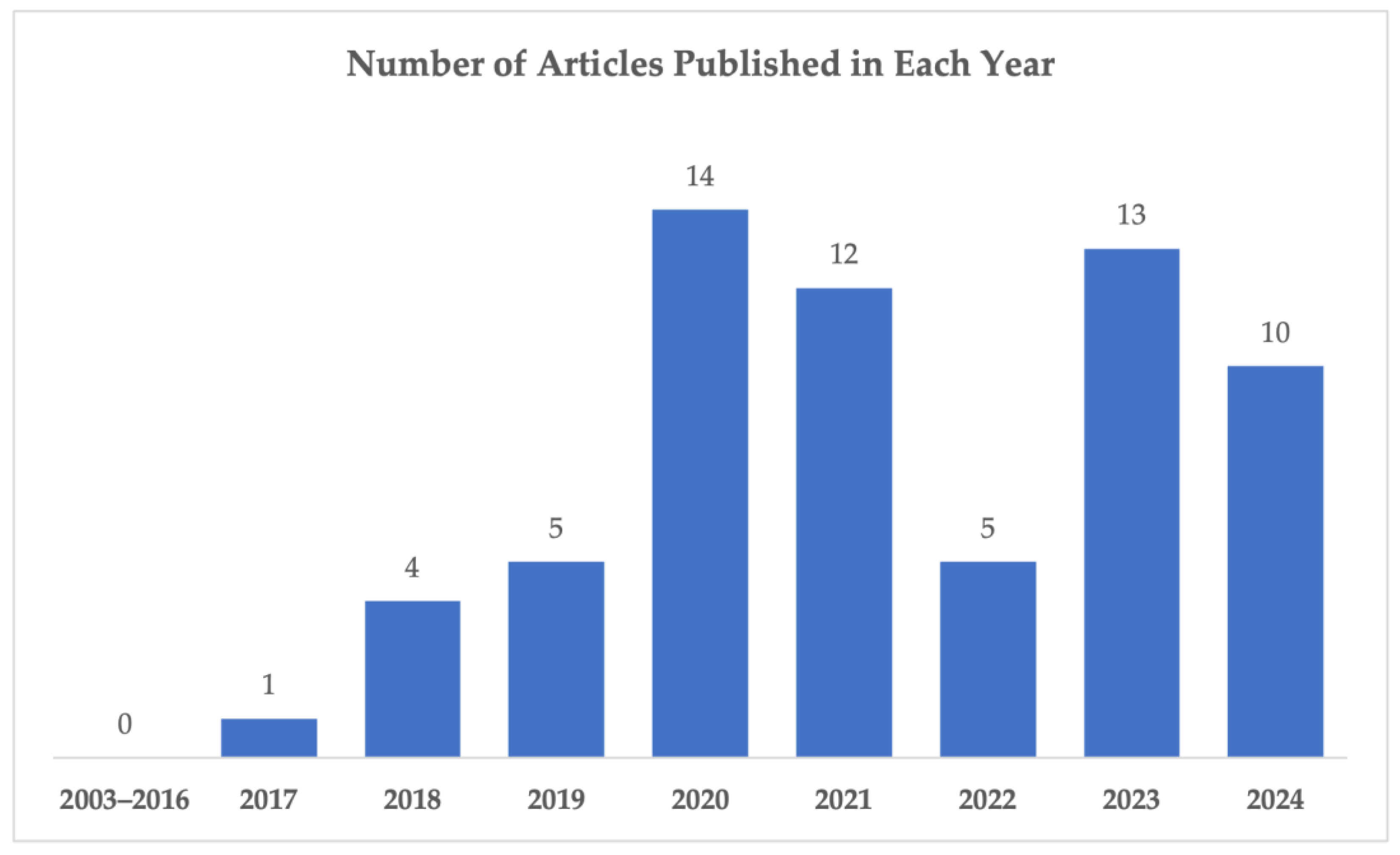
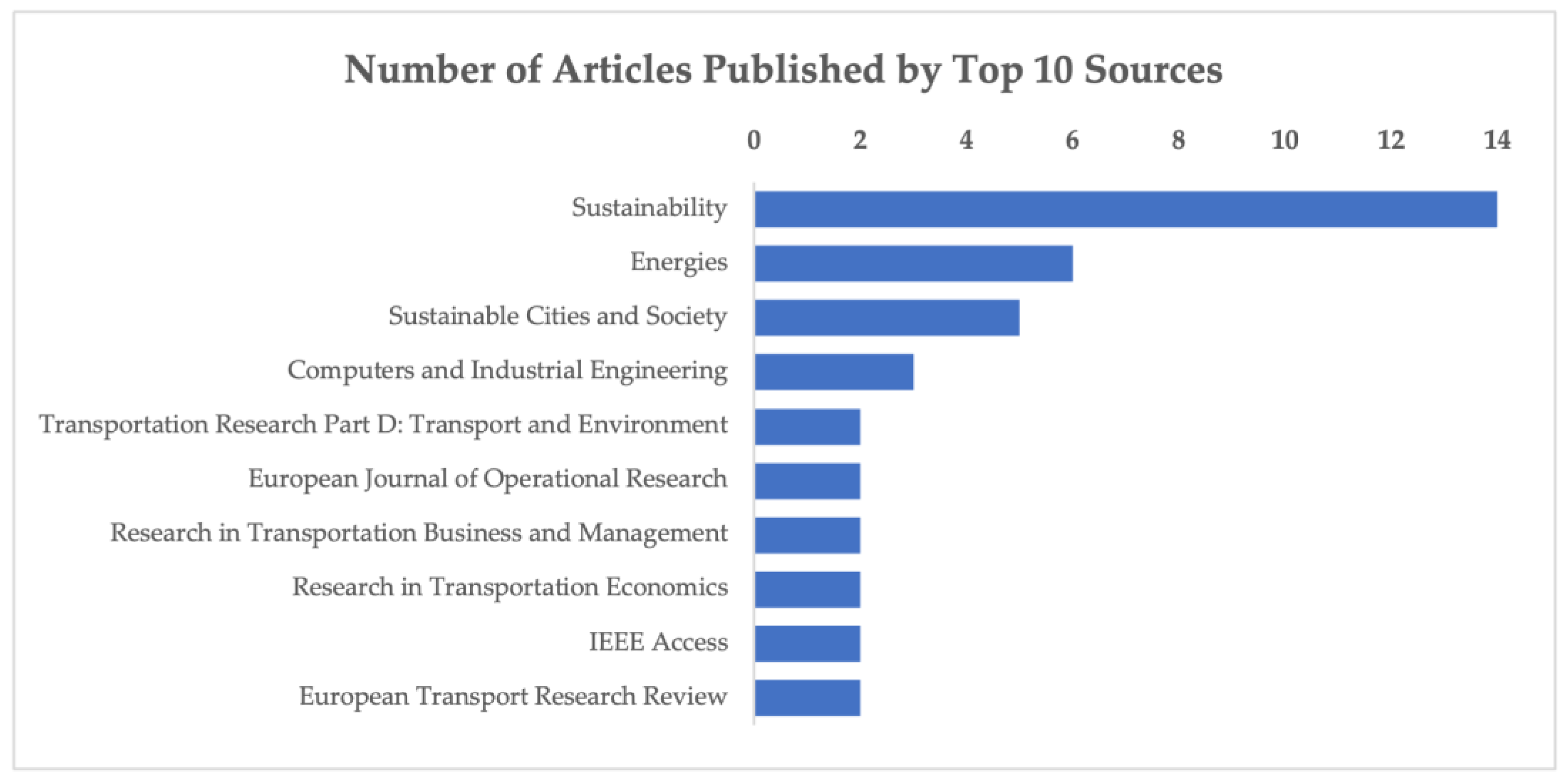


Disclaimer/Publisher’s Note: The statements, opinions and data contained in all publications are solely those of the individual author(s) and contributor(s) and not of MDPI and/or the editor(s). MDPI and/or the editor(s) disclaim responsibility for any injury to people or property resulting from any ideas, methods, instructions or products referred to in the content. |
© 2024 by the authors. Licensee MDPI, Basel, Switzerland. This article is an open access article distributed under the terms and conditions of the Creative Commons Attribution (CC BY) license (https://creativecommons.org/licenses/by/4.0/).
Share and Cite
Toktaş, D.; Ülkü, M.A.; Habib, M.A. Toward Greener Supply Chains by Decarbonizing City Logistics: A Systematic Literature Review and Research Pathways. Sustainability 2024, 16, 7516. https://doi.org/10.3390/su16177516
Toktaş D, Ülkü MA, Habib MA. Toward Greener Supply Chains by Decarbonizing City Logistics: A Systematic Literature Review and Research Pathways. Sustainability. 2024; 16(17):7516. https://doi.org/10.3390/su16177516
Chicago/Turabian StyleToktaş, Doğukan, M. Ali Ülkü, and Muhammad Ahsanul Habib. 2024. "Toward Greener Supply Chains by Decarbonizing City Logistics: A Systematic Literature Review and Research Pathways" Sustainability 16, no. 17: 7516. https://doi.org/10.3390/su16177516






